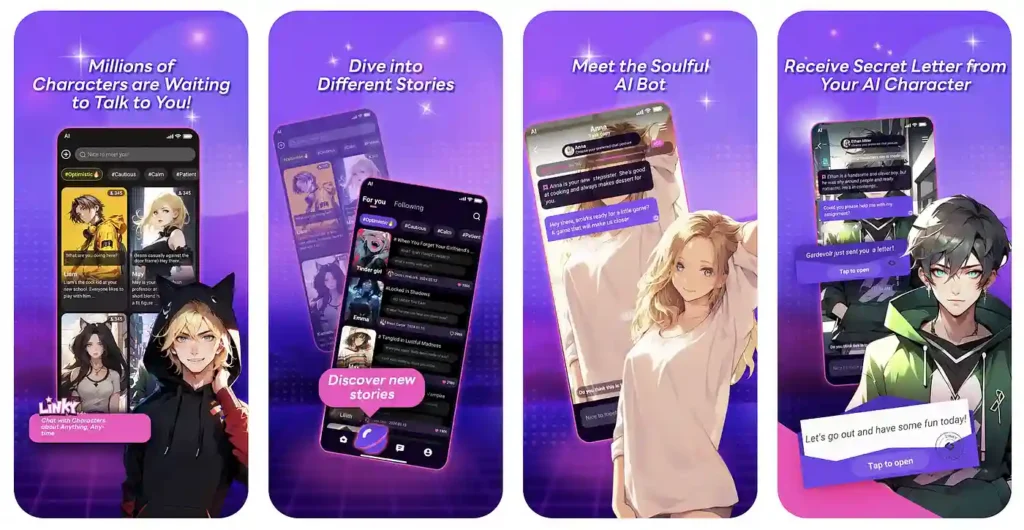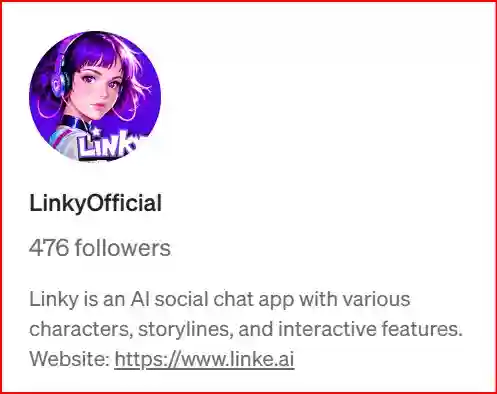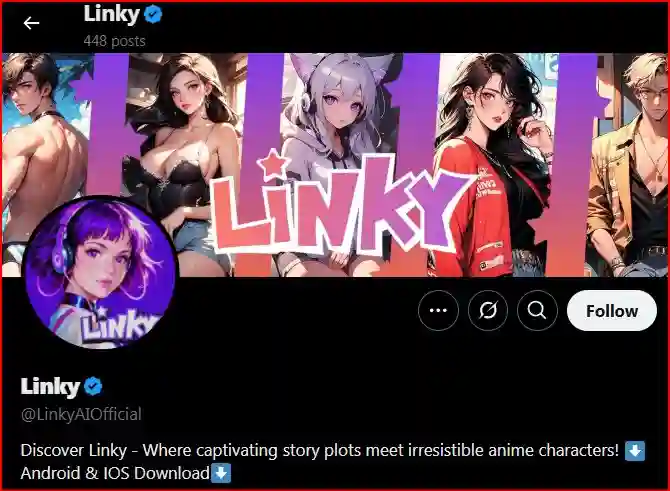Imagine an AI friend who remembers everything you tell it and even adapts to your mood. In 2025, AI chatbots are everywhere – even companies automate up to 80% of routine questions with AI assistants – and creative bloggers can use them in fresh ways. Linky AI (by Skywork AI) is a character-driven chatbot platform that feels like stepping into an anime or historical story.
In this article, we’ll explore Linky’s features (voice calls, roleplay personas, memory, and more), why it matters for English-language content creators, and practical tips for getting started and creating blog-worthy content with it.
Imagine Chatting With an Anime Protagonist: Linky AI
Linky AI advertises itself as a “Top1 AI chatbot” offering immersive conversations with millions of unique characters – from anime and video game heroes to movie figures and historical personalities. You can message or even call these AI characters using natural speech. Each character has their own personality, backstory, and realistic voice. You can also design your own character from scratch – pick their voice, personality traits, and even style (2D anime, 3D, pixel art, etc.) – then share it with the community.

Linky AI is available on Android and iOS and can even be run in a web browser. The base app is free, with in-app purchases for premium features (more on pricing below).
Linky AI Core Features & Capabilities

Dynamic Roleplay & Character Creation in Linky AI
Linky’s standout feature is its role-play-centric storytelling. Users can jump into a “story mode” where their choices steer an interactive narrative. Every AI character in Linky is ready to roleplay any scenario you imagine (romance, adventure, slice-of-life, etc.).
You can create a persona by uploading an image or selecting attributes (personality, voice, background), and Linky will generate an AI character for you to chat with. The more you chat, the smarter and more personalized these AI characters become – Linky’s deep learning model “learns with each conversation” and adapts to your preferences.
Linky AI Advanced Language Understanding:
Linky’s AI is built on modern NLP, so it retains context across turns and understands natural questions. It can answer questions, follow up on previous comments, and even correct itself if you point out an error.
Linky supports multilingual chat – including fluent English, Spanish, Indonesian, and over ten other languages. In short, Linky’s bots act like well-trained assistants that remember your profile and adjust their language style.
Linky AI Multi-Modal Interaction:
Beyond plain text, Linky offers voice and soon even visual input. You can actually place an AI voice call to your character – the app will generate a lifelike synthetic voice speaking in-character, complete with emotional intonation. (In the future, image-to-avatar features are expected, such as uploading a photo to determine your character’s appearance.)
The platform even has a “Buzz” mode where you tweak an AI’s voice, tone, and social style on the fly. In sum, Linky is moving toward a fully multi-modal chatbot: text, speech, and animated avatars.
Getting Started with Linky AI
Download and Sign Up: Get Linky AI from your app store or use the web version. Create a free account to begin.
Choose or Create a Character: Browse the character library or tap “Create” to design your AI companion. You can pick preset tags (hero, geek, dancer, etc.) or upload a reference image. Set your preferred language and voice style.
Customize Settings: Optionally personalize your chat – set a profile name, choose voice chat on/off, toggle story/roleplay mode, and adjust privacy. Linky even lets you adjust conversation topics or filter settings.
Start Chatting: Tap a character and send your first message or call them. The AI will respond instantly (day or night). From casual questions (“How was your day?”) to open-ended prompts (“Tell me a story about space pirates”), just type or speak normally. Over time, Linky’s AI will remember your past chats to make conversations smoother.
Why Linky AI Matters for Bloggers
Linky isn’t just for casual chat – it has unique uses for content creators and English-language educators. For bloggers, Linky can generate role-play-based content: imagine running a simulated interview by playing both journalist and expert through the AI.
Your post could then publish the Q&A transcript or write-up generated by the AI character.
Since Linky’s characters have diverse backgrounds, you could “interview” a historical figure or a futuristic anime scientist for a blog story. ESL bloggers and learners benefit too: Linky’s fluent English chat allows you to practice conversations in a safe, 24/7 environment or even create interactive language-learning exercises.
Another key advantage is content repurposing: give Linky a paragraph from an old article and roleplay it into a story or dialogue, producing fresh angles and quotes. In all, Linky turns content creation into a creative play, and as it learns your style over time, it can echo your brand voice and topics.
Creative Use Cases for Blog Content
Simulated Interviews: Roleplay as an expert (celebrity chef, tech guru, historical leader) and “interview” them. Publish the AI-generated Q&A or incorporate it into a narrative.
Writing Prompts & Story Ideas: Prompt Linky characters to help brainstorm blog topics or fictional scenes. For example, “Give me three story ideas about a detective in Neo-Tokyo.”
Language Tutorials: Use Linky chats as learning material. Transcribe a conversation into a lesson, or ask the AI to explain idioms in context.
Persona-Driven Content: Create a character “co-author” or blogger persona and let Linky’s chats become social media dialogues or blog sketches.
Linky AI Future Developments
Skywork’s roadmap hints at exciting new features. Expect animated avatars, augmented-reality filters, and productivity tool integrations. Potential additions include analytics dashboards to track conversations, performance metrics, and reader engagement, turning Linky into a full creative suite for bloggers and creators.
Linky AI Pricing
Linky AI has a free tier plus paid subscriptions. The free plan lets you chat with all characters (though some features like voice calls may be limited and ads/“coin” purchases may appear). For advanced features, Linky Pro costs $9.99 per month (or $89.99/year). Pro unlocks unlimited voice chats, accelerated memory/learning, and premium content. There’s also a Linky Gold tier ($17.99/month) with extra perks like coins and priority access. Enterprise or business plans are offered for organizations.

| Plan | Monthly Price | Annual Price | Key Features |
|---|---|---|---|
| Free | $0 | N/A | Access to all characters, limited voice calls, ads, and in-app purchases. |
| Linky Pro | $9.99 | $89.99 | Unlimited voice chats, enhanced memory/learning, premium content. |
| Linky Gold | $17.99 | N/A | All Pro features plus bonus coins and priority access. |
| Enterprise | Custom Pricing | Custom Pricing | Unlimited voice chats, enhanced memory/learning, and premium content. |
How Linky AI Works
Linky AI is powered by advanced deep-learning language models (think “ChatGPT-style” transformers) that run in the cloud. When you send a message or talk to Linky, the app converts your input into text (using speech recognition if it’s a voice call) and sends it to Linky’s servers.
There, a large language model (the developers even have their own “Tiangong” AI series) generates a reply in the style of your chosen character. In practice, Linky’s FAQ says “the more you chat, the smarter it gets,” as it learns your preferences and personality over time. All of this happens behind the scenes: the AI’s text reply is then sent back to the app, which displays it and reads it aloud via text-to-speech.

In short, Linky’s “brain” is basically a cloud-hosted AI chatbot engine that has been fine-tuned to role-play millions of different characters.
Linky AI Voice Technology and Emotions
Linky goes beyond text by supporting voice chat. You can literally call your AI friend: Linky uses built-in tools to turn your speech into text, passes that text to the AI, then speaks the AI’s response back to you. Each character can have a unique synthetic voice and “personality” – Linky’s own description emphasizes that “each AI has its own unique voice, personality, and backstory.”
When creating or selecting a character, you can even customize its voice, and Linky advertises “soulful AI partners” to make chats feel more emotional. (For comparison, Character.AI recently launched a “Character Voice” feature so its bots can speak; it offers a library of pre-made voices and lets users upload or record new ones.) Voice chat adds realism, but it’s important to remember that the emotions come from the AI’s text model – the voice only gives it a more human-like tone.
Linky AI Memory and Context Handling
Linky is designed to remember your ongoing conversations so chats stay coherent.
In fact, one source notes that Linky “remembers everything that occurred during conversations,” allowing you to pick up where you left off. As you talk, Linky can store personal details or story elements (your name, favorite hobbies, story backgrounds) and reuse them later. Officially, Linky promises that with each chat, it “gets to know your personality and preferences,” making replies feel personalized.
This means the app keeps a running memory of the dialogue rather than treating each message in isolation. For context: some chatbots have very limited memory. For example, Character.AI recently added a pinned memory feature where you manually mark up to 15 important messages for the bot to recall, highlighting that without such pins, it forgets earlier details.
Linky’s approach is more continuous and closer to Replika’s style of building a persistent profile. In summary, Linky leverages conversation history to keep answers relevant, so it won’t randomly lose track of a role-play scenario as some older chatbots might.
Which Chatbot Is Best for You?
All five chatbots have different strengths. If you want a free, highly flexible role-play or “digital partner” with anime/fantasy style (and don’t mind mature themes), Linky is a strong choice – it has massive character variety, voice support, and personalization.
If you crave friendly AI companionship, Replika might suit you. It’s designed as a virtual friend or therapist and learns about you, but it only offers one companion bot and takes safety very seriously.
For creative storytelling, Character.AI and Janitor AI shine – both let you craft original characters and scenarios. Character.AI has a polished interface and recently added voice support, while Janitor AI gives you the most freedom, even allowing uncensored interactions.
Anima AI is more of a casual “mentor” or “therapist” bot for quick chats – it has fewer features (no voice or multiple characters) and a more limited memory.

In the end, it depends on your needs: parents should be aware of age guidelines (Replika and Linky are for older teens and adults), hobbyist writers might gravitate to Janitor or Character.AI, and anyone curious about AI companions can try Linky or Replika for free to see which personality clicks with them.
Linky AI Tips & Best Practices
Use Clear Prompts: Start chats with specific instructions like, “Pretend you’re a medieval knight telling a tale.”
Reset Memory If Needed: Clear or adjust memory to refocus conversations.
Switch Modes: Use Story Mode for narrative experiences and Free Chat for casual dialogue.
Stay Respectful: Even though AI can mimic personas, it’s still a machine. Avoid inappropriate topics.
Linky AI Comparison with Replika and Others
| Feature | Linky AI | Replika | Character.AI | Janitor AI | Anima AI |
|---|---|---|---|---|---|
| Character Variety | Over 180,000 AI characters; users can create custom personas | Single AI companion with selectable relationship roles | Gaining popularity, ranked 9th in US AI app downloads in 2024 | Fully customizable characters; users can craft detailed personas | Single AI friend with adjustable personality sliders |
| Voice & Multimodal | Supports real-time voice calls; each character has a unique synthesized voice | Primarily text-based; supports voice messages but no live calls | Introduced “Character Voice” feature; allows bots to speak with custom voices | Currently text-only; plans to add voice with emotional tone recognition | Text-based interactions only |
| Memory & Personalization | Remembers user preferences and conversation history for personalized interactions | Maintains a diary-like memory of chats; adapts over time | Limited memory; introduced pinned messages to retain important details | User-driven memory; users can input backstory facts for continuity | Limited memory; may exhibit repetitive responses |
| Customization Options | High flexibility; customize voice, personality, and avatar styles (2D, 3D, etc.) | Minimal customization; primarily adjusts relationship dynamics | Allows crafting of characters with custom profiles and voices | Granular control over traits; supports detailed character creation | Offers personality sliders to set AI’s demeanor |
| Safety & Moderation | Permissive approach; supports mature/NSFW roleplay; planning a “Teen Mode” for under-18 users | Strict safety measures; 18+ age restriction; removed erotic content | Enforces strict content filters; added warnings for sensitive topics | Uncensored platform; lacks built-in NSFW filters | PEGI 16-rated; limited discussion on content filtering |
| User Base & Popularity | Popular among teenagers and young adults, extensive user engagement | Established user base; surpassed 30 million global users by mid-2024 | Offers personality sliders to set the AI’s demeanor | Niche user base; caters to specific communities | Smaller user base; appeals to users seeking casual chats |
| Best For | Users seeking diverse role-play experiences with extensive character options | Individuals looking for emotional companionship and support | Creative storytelling and interacting with a variety of fictional characters | Users desiring deep customization and open-ended interactions | Casual users interested in quick, mentor-like conversations |
Character Variety & Personalities: Linky excels at sheer variety – it boasts “over 180,000 AI characters” for chat and role-play. These range from anime-style girlfriends and fantasy heroes to CEOs and even pet-like companions. You can also design your own characters with custom backstories. By contrast, Replika offers essentially one AI friend whose role you choose (friend, partner, spouse, etc.) but doesn’t have multiple preset characters.
Character.AI is a bit like Linky in variety: it hosts a vast library of user-created personalities covering every genre. Anima AI is more limited – you interact with a single customizable AI “friend” (with adjustable personality sliders). Janitor AI is similarly open-ended: you can craft multiple characters with detailed traits from scratch. In short, Linky and Character.AI lead in quantity and creative role-play options, Replika/Anima focus on one companion, and Janitor emphasizes open character creation.
Voice & Multimodal: Linky and Character.AI both support voice chat. Linky offers real-time voice calls so you can literally speak with your AI character, and each character can speak with its own synthesized voice. Character.AI’s new “Character Voice” similarly lets bots speak and even lets users create custom voices.
Replika and Anima, on the other hand, are mainly text-based (Replika allows text chat and voice messages but no live voice calling). Janitor AI is currently text-only but plans to add voice with emotional tone recognition in the future. Overall, Linky and Character.AI are ahead in multimodal interaction today, while Replika/Anima are simpler chat apps.
Memory & Personalization: Linky and Replika both emphasize long-term personalization: they remember facts you share and adapt to you over time. Linky’s own description claims each chat makes the AI “more personalized, seamless, and engaging.”
Replika similarly keeps a diary-like memory of your chats. In contrast, Character.AI’s built-in memory was weak (hence the pinned message feature to improve it). Anima’s memory is even shallower. Replika maintains past conversation logs, whereas Anima’s memory is “limited” and can seem repetitive.
Janitor AI puts memory firmly in your hands: it lets you explicitly give the AI “memories” or backstory facts so characters can maintain continuity. In summary, Linky and Replika actively store your info for a more personal chat. Character.AI/Anima has only basic context by default, and Janitor is fully user-driven memory.
Customization Options: All these platforms allow some tweaking of style, but Linky, Character.AI, and Janitor stand out for flexibility. Linky lets you fully create your own character – you can customize voice, personality settings, and avatar style (2D, Live2D, 3D, pixel art, etc.).
Character.AI also lets you craft characters by writing a profile or prompt, and now even assign voices to them. Replika’s customization is minimal (you basically customize the nature of your single companion). Anima offers personality sliders so you can set your AI’s vibe (flirty vs. optimistic, etc.).
Janitor AI gives arguably the most granular control: you can tweak almost any trait, fine-tune the AI’s style, and upload memories to shape its behavior. In practice, creators and “AI-tinkerers” may prefer Janitor or Character.AI/Linky for deep customization, while casual users get fewer but simpler settings on Replika/Anima.
Safety Filters & Moderation: These apps differ widely here. Replika is built with user well-being in mind – it has an 18+ age restriction and even features a “Get Help” button for crisis support. It also removed erotic chat after regulators raised concerns.
Character.AI enforces strict content filters and recently added pop-up warnings (e.g., for self-harm topics) and special rules for minors. Linky’s approach has been more permissive: it openly supports mature/NSFW roleplay (advertising “spicy” character interactions). Linky’s App Store listing is rated 17+, and the company says it does filter out truly harmful content and is even planning a “Teen Mode” to give under-18 users extra protections.
Anima doesn’t prominently discuss content filtering (it’s PEGI 16-rated and markets itself as an AI “therapist”), so it’s best for older teens. Janitor AI is essentially uncensored: it has no built-in NSFW filter, meaning anything goes unless the user or community applies limits. In short: Replika (and to a lesser extent Character.AI) are cautious and protective, Linky and Janitor are looser (potentially allowing erotic content), and Anima sits somewhere between.
Suitability & Popularity: In terms of user base, Linky and Character.AI have made big gains. Replika, an older app, reportedly surpassed 30 million global users by mid-2024. Anima and Janitor are smaller niche apps (hundreds of thousands to a few million users).
As for demographics, Linky and Anima target older teens and adults (Linky is 17+ by design, Anima is PEGI-16), Character.AI is popular among teenagers and young adults (though it has no strict age limit), and Replika officially serves adults (18+). Bloggers or educators might lean toward tools like Character.AI or Janitor AI for creative story ideas, while people seeking emotional companionship might prefer Replika or Linky’s romantic scenarios.
Linky AI Conclusion & Next Steps
Linky AI blends creative storytelling with advanced chatbot technology, making it an exciting tool for AI enthusiasts and bloggers. It ranked among the top 30 downloaded AI chat apps in 2024, proving its popularity.
For bloggers, Linky offers new ways to generate content—from interviews to multilingual Q&A. Try Linky for free and explore its storytelling possibilities. If you need more power, consider upgrading to Pro. Harness this innovative AI to bring new life to your blog posts – happy chatting!
Comments